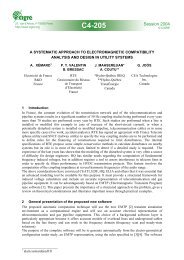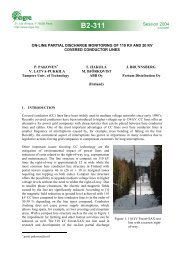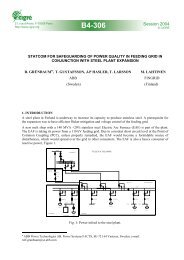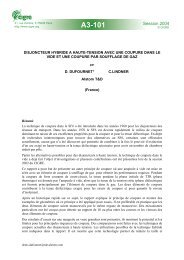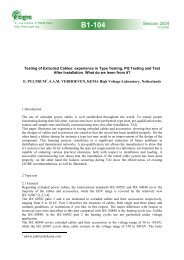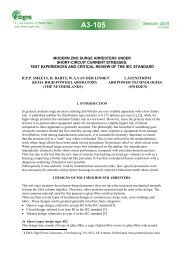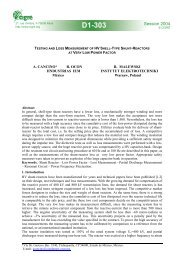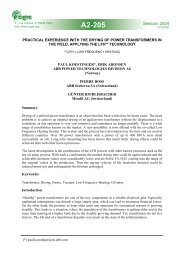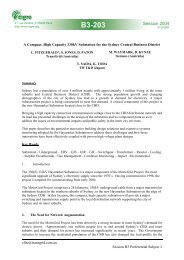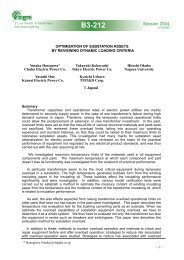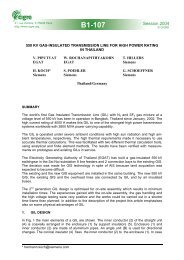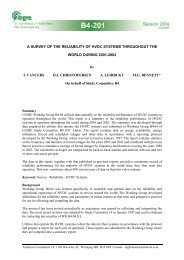First steps in hydrogen production from wind energy in Greece
First steps in hydrogen production from wind energy in Greece
First steps in hydrogen production from wind energy in Greece
Create successful ePaper yourself
Turn your PDF publications into a flip-book with our unique Google optimized e-Paper software.
The ma<strong>in</strong> characteristics of the different electricity users are presented <strong>in</strong> Table I, and some more<br />
detailed explanations are given hereafter.<br />
Item<br />
1. Electrolyser<br />
Power<br />
Supply<br />
Cab<strong>in</strong>et<br />
2. Compressor<br />
3. MHT heater<br />
4. Cool<strong>in</strong>g<br />
water<br />
refrigerat<strong>in</strong>g &<br />
pump<strong>in</strong>g unit<br />
5. Central<br />
Control Unit<br />
Table I. Ma<strong>in</strong> power characteristics of the different plant units<br />
Ma<strong>in</strong> Power Characteristics<br />
The electrolyser cab<strong>in</strong>et <strong>in</strong>cludes the AC/DC converter to supply the electrolysis<br />
stack with the appropriate DC power. The operat<strong>in</strong>g range of the electrolyser is<br />
3.75 – 25 kW, correspond<strong>in</strong>g to a <strong>hydrogen</strong> <strong>production</strong> of 0.75 – 5 Nm 3 /h. A fullrange<br />
power variation is possible with<strong>in</strong> 1 second.<br />
The correspond<strong>in</strong>g power necessary for cool<strong>in</strong>g the water and pump<strong>in</strong>g it <strong>in</strong>to the<br />
system varies <strong>in</strong> the range 0 – 4 kW, but not <strong>in</strong> a l<strong>in</strong>ear manner.<br />
The power <strong>in</strong>put to the compressor will be circa 5 – 7.5 kW, to be precisely<br />
def<strong>in</strong>ed by the manufacturer (not chosen yet). It must rema<strong>in</strong> rather constant, but<br />
an eventual variation range must be checked with the manufacturer.<br />
At full power, the compressor should need approximately 4 kW for cool<strong>in</strong>g water<br />
and recirculation pump<strong>in</strong>g.<br />
Dur<strong>in</strong>g <strong>hydrogen</strong> delivery, the Metal Hydride Tank must be heated. At nom<strong>in</strong>al<br />
discharge rate, i.e. 5 Nm 3 /h H 2 , approximately 2 kW power are needed. Dur<strong>in</strong>g<br />
<strong>hydrogen</strong> absorption, the Metal Hydride Tank may need cool<strong>in</strong>g, with<br />
approximately 2 kW cool<strong>in</strong>g required at the absorption rate of 5 Nm 3 /h. The<br />
heat<strong>in</strong>g and cool<strong>in</strong>g power may vary as a function of the absorption and desorption<br />
pressure and temperature.<br />
Dur<strong>in</strong>g normal operation, the maximum quantity of cool<strong>in</strong>g water may be needed<br />
dur<strong>in</strong>g the simultaneous operation of the electrolyser and compressor. It<br />
corresponds to 8 kW cool<strong>in</strong>g <strong>energy</strong>. So, the <strong>energy</strong> for the refrigeration of the<br />
cool<strong>in</strong>g water will vary <strong>in</strong> the range 0 – 8 kW.<br />
The CCU needs some power, <strong>in</strong> order to receive signals, treat them and send other<br />
signals to the different control elements of the plant. The data monitor<strong>in</strong>g is also<br />
<strong>in</strong>cluded <strong>in</strong> the CCU. CCU power consumption is estimated around 1 kW.<br />
The PCU will be <strong>in</strong>stalled <strong>in</strong> a non hazardous zone of the plant. A m<strong>in</strong>imum distance of 5 meters is<br />
foreseen <strong>from</strong> the zones with possible presence of <strong>in</strong>flammable gases, accord<strong>in</strong>g to the available codes<br />
of practice.<br />
5. FUTURE APPLICATIONS FOR SIMILAR WIND-HYDROGEN SYSTEMS<br />
The concept of us<strong>in</strong>g <strong>hydrogen</strong> as a medium for the storage of excess w<strong>in</strong>d <strong>energy</strong> through water<br />
electrolysis with fuel cells used for re-electrification is considered ideal for most of the non<strong>in</strong>terconnected<br />
Greek islands. Adequate <strong>hydrogen</strong> storage capacity would allow for the seasonal<br />
storage of this <strong>energy</strong>, which is most suitable for autonomous grids like for the case of islands.<br />
Hydrogen produced <strong>in</strong> this way can be used as a replacement of liquid fuels for heat<strong>in</strong>g and<br />
transportation purposes. A pre-feasibility study related to the <strong>in</strong>troduction of a w<strong>in</strong>d-<strong>hydrogen</strong> <strong>energy</strong><br />
system <strong>in</strong> the island of Kythnos is briefly presented. It must be noted that the proposed system design<br />
and dimension<strong>in</strong>g was performed with the TRNSYS simulation tool where the HYDROGEMS library<br />
of modules has been <strong>in</strong>corporated [6].<br />
Kythnos island <strong>in</strong> <strong>Greece</strong> has a peak power demand of approximately 2.5 MW and is electrified<br />
ma<strong>in</strong>ly by diesel generators sets. A w<strong>in</strong>d turb<strong>in</strong>e with a nom<strong>in</strong>al power of 500 kW and a photovoltaic<br />
system of around 100 kW have also been <strong>in</strong>stalled on the island. The ma<strong>in</strong> problem related to the w<strong>in</strong>d<br />
7



